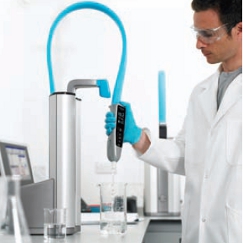Industrial designers are often accused of not shouting loudly enough about what they do. They while away their time under mountains of project work in their consultancy studios or within in-house teams with no one really realising what it is they do.
But you only need to read the articles written in this magazine to see how an investment in design can positively impact a company’s bottom line. Strategic design can be used as a competitive advantage to reduce costs, increase profits and lead to growth.
One organisation that aims to shout loudly on behalf of industrial designers, service designers and innovation professionals is British Design Innovation (BDI). Founded in 1993, BDI is an independent not-for-profit organisation financed by its members and managed by 30 regional board directors.
In January the BDI’s chief executive Maxine Horne, who had been at the helm for 17 years, stepped down to pursue her new business venture, Creative Barcode.
Following her departure, the board, led by Gus Desbarats as chairman, restructured the management around a more active board, supported by a small management team, who then proceeded with a major change programme.
All change
Following these changes, Desbarats, who is also chairman of design consultancy TheAlloy, is calling out for new members to join. “We are the only national trade body to specifically support the contribution of industrial and service designers and others in the innovation space. BDI wants new members to lead the British vanguard,” he says.
A platform that enabled the BDI to reach out to industrial designers was the inaugral Product Design and Innovation (PD+I) conference, which recently took place in London.
In the BDI session – ‘Raising the Profile of Product Design’ – Desbarats, together with two fellow BDI directors, highlighted the need for a stronger voice for industrial and service design in the UK and to promote the role the BDI is playing to raise the profile and perceived value of all designers in this space.
Desbarats stressed that although industrial designers are a minority by number compared to other designers, they are very influential.
“While the industrial design sector represents only 20 per cent of the UK’s £15 billion commercial design industry, it generates 80 per cent of its value,” he explained.
Product vs industrial design
He was also clear that the organisation is representing industrial design as opposed to product design as he feels the latter is too narrowing. He argues that industrial design is a more broadly-based strategic offer.
Its skills set extends beyond traditional object creation skills to include, amongst other things, innovation strategy, ethnographic research skills, brand narrative, software design, service system design, implementation feasibility, specification and sourcing.
He went on to discuss the BDI 2011 Change Plan outlining how the organisation intends to expand the profile, status and influence of its members and promote better knowledge trading opportunities to the wider world.
For the industrial design consultancy sector, BDI’s core audience, there is a new and enhanced package of promotional benefits, service delivery improvements and a revised fee structure, which will be frozen for two years. In addition, two new membership categories have been created that benefit in-house industrial design teams and other individuals.
Desbarats also emphasised that the BDI national board has no intention of turning into a cosy closed shop. “For the first time we have a constitution that clearly states that the national board will serve limited terms and be elected by the members. There will be a three-year term limit (maximum two terms) for national directors,” he stated.
In practice
Following Desbarats, Les Stokes founding partner of LA Design and national director for BDI, talked about the ELGA LabWater’s PURELAB flex project (below) whilst Steve May-Russell, managing director of Smallfry and West Midlands regional director of BDI, presented a case study on the Metrasens FerroGuard metal detection system demonstrating how strategic design enabled the client to significantly reduce manufacturing costs and increase turnover.
“This project clearly demonstrates what industrial designers can do. We can help the manufacturing industry get back on its feet,” said May-Russell. “People have woken up to the strategic importance of using industrial design and its not just slapping lipstick on a pig.”
He urged new members to join saying, “The BDI is a collaborative network of fired up, supportive strategic thinkers. I think it’s time that we recognise that no one of us is as good as all of us, we have far more to gain from working together.”
Desbarats drew the session to a close with a final recruitment pitch. “This is a call to every product, interaction and service designer in the country, and anyone who wants to work with us, to join our community and help us help you all.
We also want to invite anyone keen to engage with industrial designers to cocreate great experience-led innovation to get in touch too,” he concluded.
The difference industrial design can make
As part of the BDI session at the Product Design and Innovation conference Les Stokes, founding partner of design consultancy LA Design and national director of the BDI, took to the stage to present the ELGA PURELAB flex case study.
It was a cocreation presentation with the client Lee Underwood, head of engineering at ELGA LabWater Global Operations.
The pair demonstrated how a highly successful collaboration not only creates commercial advantage but can also change the culture of a manufacturing company and its attitude towards industrial design.
Flex is the world’s first standalone ultrapure water system, small enough to fit on every scientist’s bench. It provides local and accurate measured dispensing, eliminating transportation from a central source and eradicating contamination, spillage and water waste by overfilling.
Stokes and Underwood explained how the flex project was driven by commercial necessity and required significant research and innovation to develop a strong brand. This included the product platform, user manuals, packaging and digital video promotional material.
The results have disrupted the market, increased sales and elevated ELGA’s status as a manufacturing organisation within the Veolia Water group of companies.
“Previously, ELGA had viewed external industrial design input as a cosmetic enhancement for tried and tested solutions – the company now embraces design and innovation as an essential strategic business tool,” commented Stokes.
There were a number of conclusions that arose from the project. Firstly, entrenched company attitudes, which included a fear of external input, can rapidly change into a positive, well motivated force for change when successful results are properly communicated throughout the organisation.
Secondly, design can be much more than a method for ‘papering over the cracks,’ when strategic thinking is paired with a ‘product champion’, in this case Underwood. “Risk taking can be highly successful with the right partnership,” concluded Stokes. 
British Design Innovation is calling out for new members to join
Default








